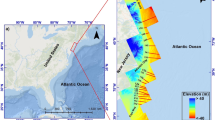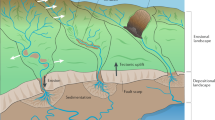Abstract
Desert dunes often exhibit remarkable changes in their morphology over short distances. For example, sediment-rich dunes can break up into smaller, isolated features, and then become stabilized by plants, over distances of kilometres1,2,3,4,5,6. These pattern transitions often coincide with spatial variations in sediment supply1,3,5, transport rate6,7, hydrology8 and vegetation9,10,11, but these factors have not been linked mechanistically. Here we hypothesize that the abrupt increase in roughness at the upwind margins of dune fields triggers the development of an internal boundary layer12,13,14,15,16,17,18 that thickens downwind and causes a spatial decrease in the surface wind stress. We demonstrate that this mechanism forces a downwind decline in sand flux at White Sands, New Mexico, using a combination of physical theory14,15,16,17,18,19, repeated airborne altimetry surveys and field observations. The declining sand flux triggers an abrupt increase in vegetation density, which in turn leads to changes in groundwater depth and salinity—showing that aerodynamics, sediment transport and ecohydrology are tightly interconnected in this landscape. We conclude that, despite the documented complex climatic and geologic history of White Sands20, internal boundary layer theory explains many of the observed first-order patterns of the dune field.
This is a preview of subscription content, access via your institution
Access options
Subscribe to this journal
Receive 12 print issues and online access
$259.00 per year
only $21.58 per issue
Buy this article
- Purchase on Springer Link
- Instant access to full article PDF
Prices may be subject to local taxes which are calculated during checkout




Similar content being viewed by others
References
Bagnold, R. A. The Physics of Blown Sand and Desert Dunes (Methuen, 1941).
McKee, E. D. Structures of dunes at White Sands National Monument, New Mexico (and a comparison with structures of dunes from other selected areas). Sedimentology 7, 3–69 (1966).
Lancaster, N. Winds and sand movements in the Namib Sand Sea. Earth Surf. Process. Landforms 10, 607–619 (1985).
Kocurek, G. et al. White Sands Dune Field, New Mexico: Age, dune dynamics and recent accumulations. Sedim. Geol. 197, 313–331 (2007).
Pye, K. & Tsoar, H. Aeolian Sand and Sand Dunes (Springer, 2009).
Ewing, R. C. & Kocurek, G. A. Aeolian dune interactions and dune-field pattern formation: White Sands Dune Field, New Mexico. Sedimentology 57, 1199–1219 (2010).
Illenberger, W. K. & Ruse, I. C. A sand budget for the Alexandria coastal dunefield, South Africa. Sedimentology 35, 513–521 (1988).
Langford, R., Rose, J. & White, D. Groundwater salinity as a control on development of eolian landscape: An example from the White Sands of New Mexico. Geomorphology 105, 39–49 (2009).
Duran, O. & Herrmann, H. Vegetation against dune mobility. Phys. Rev. Lett. 97, 188001 (2006).
Baas, A. C. W. & Nield, J. M. Modelling vegetated dune landscapes. Geophys. Res. Lett. 34, L06405 (2007).
Reitz, M. D., Jerolmack, D. J., Ewing, R. C. & Martin, R. L. Barchan–parabolic dune pattern transition from vegetation stability threshold. Geophys. Res. Lett. 37, L19402 (2010).
Hsu, S. A. Boundary-layer meteorological research in the coastal zone. Geosci. Man XVIII, 99–111 (1977).
Rasmussen, K. R. Some aspects of flow over coastal dunes. Proc. R. Soc. Edinb. B 96, 129–147 (1989).
Bradley, E. F. A micrometeorological study of velocity profiles and surface drag in the region modified by a change in surface roughness. Q. J. R. Meteorol. Soc. 94, 361–379 (1968).
Rao, K. S., Wyngaard, J. C. & Coté, O. R. The structure of the two-dimensional internal boundary layer over a sudden change of surface roughness. J. Atmos. Sci. 31, 738–746 (1974).
Wood, D. H. Internal boundary layer growth following a step change in surface roughness. Bound.-Layer Meteorol. 22, 241–244 (1982).
Stevenson, D. C. & Lee, W. L. Proc. 9th Australasian Fluid Mech. Conf. 379–382 (University of Auckland, 1986).
Garratt, J. R. The internal boundary layer: A review. Bound.-Layer Meteorol. 50, 171–203 (1990).
Jerolmack, D. J., Reitz, M. D. & Martin, R. L. Sorting out abrasion in a gypsum dune field. J. Geophys. Res. 116, F02003 (2011).
Langford, R. The Holocene history of the White Sands dune field and influences on eolian deflation and playa lakes. Quat. Int. 104, 31–39 (2003).
Fryberger, S. Geological overview of White Sands National MonumentPreprint at http://www.nps.gov/archive/whsa/Geology%20of%20White%20Sands/GeoHome.html (2009).
Szynkiewicz, A. et al. Origin of terrestrial gypsum dunes—implications for Martian gypsum-rich dunes of Olympia Undae. Geomorphology 121, 69–83 (2010).
Newton, T. 2010 Annual Report to the National Park Service (National Park Service, 2010).
Antonia, R. A. & Luxton, R. E. The response of a turbulent boundary layer to a step change in surface roughness. Part 1. Smooth to rough. J. Fluid Mech. 48, 721–761 (1971).
Glauert, M. B. The wall jet. J. Fluid Mech. 1, 625–643 (1956).
Chen, J. S. et al. Water resources: Groundwater maintains dune landscape. Nature 432, 459–460 (2004).
Runyan, C. & D’Odorico, P. Ecohydrological feedbacks between salt accumulation and vegetation dynamics: Role of vegetation–groundwater interactions. Wat. Resour. Res. 46, W11561 (2010).
Lehmann, P., Assouline, S. & Or, D. Characteristic lengths affecting evaporative drying of porous media. Phys. Rev. E 77, 056309 (2008).
Gribovszki, Z., Szilágyi, J. & Kalicz, P. Diurnal fluctuations in shallow groundwater levels and streamflow rates and their interpretation—a review. J. Hydrol. 385, 371–383 (2010).
Maxwell, R. M. & Kollet, S. J. Interdependence of groundwater dynamics and land-energy feedbacks under climate change. Nature Geosci. 1, 665–669 (2008).
Acknowledgements
Research partially supported by the National Science Foundation through EAR-PF-0846233 to R.C.E., and EAR-0810038 to D.J.J. We thank K. Litwin, A. Bhattachan, A. Boles and B. McNutt for their assistance in collecting these data. We are especially grateful to D. Bustos of the National Park Service (NPS) for facilitating this study. Lidar data supplied by G. Kocurek, funded by a grant from NPS as part of the Chihuahuan Desert Network Inventory and Monitoring Program. Ideas and suggestions by G. Kocurek and D. Mohrig improved the paper.
Author information
Authors and Affiliations
Contributions
All authors contributed equally to data collection and analysis. D.J.J. designed the study with input from R.C.E., F.F., R.L.M., C.P. and M.D.R. The paper was written by D.J.J. and edited by all authors. I.B. and C.M. led the groundwater component.
Corresponding author
Ethics declarations
Competing interests
The authors declare no competing financial interests.
Supplementary information
Supplementary Information
Supplementary Information (PDF 42051 kb)
Rights and permissions
About this article
Cite this article
Jerolmack, D., Ewing, R., Falcini, F. et al. Internal boundary layer model for the evolution of desert dune fields. Nature Geosci 5, 206–209 (2012). https://doi.org/10.1038/ngeo1381
Received:
Accepted:
Published:
Issue Date:
DOI: https://doi.org/10.1038/ngeo1381
This article is cited by
-
Lag in response of coastal barrier-island retreat to sea-level rise
Nature Geoscience (2022)
-
What sets aeolian dune height?
Nature Communications (2022)
-
Spatially and temporally distributed data foraging decisions in disciplinary field science
Cognitive Research: Principles and Implications (2021)
-
Retreating marsh shoreline creates hotspots of high-marsh plant diversity
Scientific Reports (2019)
-
Turbulence Coherence Within Canonical and Realistic Aeolian Dune-Field Roughness Sublayers
Boundary-Layer Meteorology (2019)



